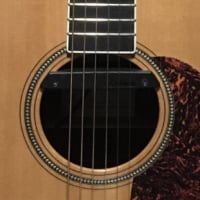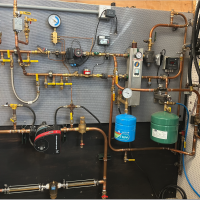Welcome! Here are the website rules, as well as some tips for using this forum.
Need to contact us? Visit https://heatinghelp.com/contact-us/.
Click here to Find a Contractor in your area.
If our community has helped you, please consider making a contribution to support this website. Thanks!
CI Rad; Pressure Test
Options

D107
Member Posts: 1,944
Just lugged a new OCS 8 section Cast Ray rad home, and as I rolled it slowly bottom to top to move it noticed rattling inside seeming to come from the top. Should I return it? Maybe it's just a loose bit of casting excess that will come out in my Adey filter? I also found a circular piece of CI just inside the input connection--perhaps the rattling is from the same kind of piece on the output side? Output side has piece of protective plastic covering, input does not. Would rather not lug this thing back.








0
Comments
-
I would pressure test to see if the casting is watertight. You can use compressed air at 30psi (15 psi for steam) and see if the gauge drops over an hour or less.
I would also voice my concerns to the supplier. Ask for their opinion on when the warranty starts Date of purchase or date of commissioning?. Especially if you are on a project that will not be filled with water within the next few weeksEdward Young Retired
After you make that expensive repair and you still have the same problem, What will you check next?
1 -
@EdTheHeaterMan Supplier is easy about returns, though I should get the time frame in writing. Of course the rattling could just be debris--the pressure test I guess is something most heating guys should do with any new rad.
Wonder how I could do this myself. the inputs and outputs are 1.25" so on one end goes a 1.25" plug. then what? Can I do this with a bicycle pump and a gauge? but how to make that connection.....Rep told me he's seen leaks on the OCS baseboard but never on the cast rays....0 -
-
Thanks so just so I understand:
1-plug in one 1.25" connection side hopefully only using teflon tape not pipe dope.
2-Bush one 1.25" other connection side down from 1.25" to 1/2", then screw in 1/2" threaded test gauge then attach bike pump end to schrader on the gauge?
3-Pump to 30psi wait 15 minutes, check pressure.
An older thread on this subject says water test is better for showing leak location but if I find a leak I won't care where it is I'll just return the rad.
Also on thread: "Using water is safer too. If a bad section lets go, the resulting explosion from a rad filled with air can hurt someone. With water there isn't nearly the amount of explosive energy. But you still need to be careful! "
"The air sometimes does not show any leaks. The water will show more of the leaks. Also remember when the radiators heat up to 180 degrees and 12 pounds leaks show that did not show at room temperature and 60 pounds of air pressure."-1 -
If there is a leak you want to make sure it is not at the plugs or the gauge, so in that respect you do care where the leak is. If you have a leak at 30 psig that shows up as a drop of a couple psi over a couple hours or a day, if you pump it up to maybe 75 or 100 it will leak faster and you will be able to usually hear where it is leaking, if not you can find it with soap. It leaking when it heads up and expands is always a possibility but relatively unlikely if it doesn't leak cold.1
-
-
I think this is a better idea if the Radiator is still outside!hot_rod said:I'd use two bushings, one with a pressure gauge, the other with a garden hose adapter, pressurize to 30 psi with water, let it set an hour or so.
If the radiator is already in the room, Where will the water go when you empty it. Now you need a pump and more hoses, some towels, maybe some plaster to fix the ceiling below from the water leaking thru the floor, a quart of matching ceiling paint, some paintbrushes, a paint roller, a ladder, some more rags to clean up the paint you spilled, more spackle to fix the dent in the wall you made with the ladder... and on... and on
Can you tell I watched the Three Stooges as a Youngster?Edward Young Retired
After you make that expensive repair and you still have the same problem, What will you check next?
1 -
@EdTheHeaterMan yes I was hoping I could find a Three Stooges hydronic episode--though I know there are plenty of unfilmed ones that go on every day. Luckily the rad is in a porch a few feet away from the door and wooden deck so I could arrange this without too much trouble. Just that I'm juggling quite a few projects right now--everything's ganging up at once.
0 -
Garden hose from outside with isolation ball valve on one end of rad......pressure indicator on the other end of rad.
Run pressure up as wanted, close isolation valve.
Wait as long as you want.
Disconnect hose from outside wall hydrant, open ball valve and water the grass.
This will put some water in the lower sections and compress the air in the top of rad. You could bleed the air out if there is an 1/8" plug near the top.
The water might wash the debris to your drain end.1 -
plenty of us boomers filled and emptied water beds insides homes🏡. I suspect a garden hose could do the same attached to a radiator?
Since eventually the rad will contain water, that is how I would test it A tiny air leak between sections of a radiator may be tough to pinpoint. No way would I go beyond 30 psi air or waterBob "hot rod" Rohr
trainer for Caleffi NA
Living the hydronic dream1 -
yep, whatever valve you connect the hose to. Or add an additional valve at the radiator if that helps regulate and shut off the flow at 30 psiBob "hot rod" Rohr
trainer for Caleffi NA
Living the hydronic dream0 -
The ball valve at the rad gives you control of the water flow and pressure right at the rad.
Hot Rod, you may have to explain the term "water bed" to some youngsters here...... did you ever heat your water bed with boiler water?0 -
JUGHNE said:
I actually did put some pex under a waterbed my son had, that was maybe 18 years ago, long after the 1960-70's rage of water beds.The ball valve at the rad gives you control of the water flow and pressure right at the rad. Hot Rod, you may have to explain the term "water bed" to some youngsters here...... did you ever heat your water bed with boiler water?
It didn't really work so well, should have included transfer plates Bob "hot rod" Rohr
Bob "hot rod" Rohr
trainer for Caleffi NA
Living the hydronic dream1 -
x0
-
@hot_rod Bob... the transfer plates with sharp corners would have worked great for the results in my previous post LOL
Edward Young Retired
After you make that expensive repair and you still have the same problem, What will you check next?
0 -
xx0
Categories
- All Categories
- 87.3K THE MAIN WALL
- 3.2K A-C, Heat Pumps & Refrigeration
- 61 Biomass
- 427 Carbon Monoxide Awareness
- 119 Chimneys & Flues
- 2.1K Domestic Hot Water
- 5.8K Gas Heating
- 115 Geothermal
- 165 Indoor-Air Quality
- 3.7K Oil Heating
- 76 Pipe Deterioration
- 1K Plumbing
- 6.5K Radiant Heating
- 395 Solar
- 15.6K Strictly Steam
- 3.4K Thermostats and Controls
- 56 Water Quality
- 51 Industry Classes
- 49 Job Opportunities
- 18 Recall Announcements

